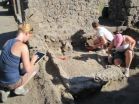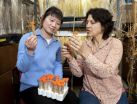(Press-News.org) WASHINGTON, April 7, 2011 -- Dozens of researchers in the coming days will lay out what's around the corner in the biochemical battle of the bulge as part of the Experimental Biology 2011 conference in Washington, D.C.
The three-day program on obesity, sponsored by the American Society for Biochemistry and Molecular Biology's minority affairs committee, will showcase the work of scientists from all over the world who have their sights set on reversing the epidemic by laying bare and manipulating, to mankind's advantage, its molecular underpinnings.
Nine 25-minute talks and numerous other shorter presentations will be given in Room 202B of the Walter E. Washington Convention Center. The program will be divided into the following three themes.
Frontiers in obesity research: During the first round of talks, from 9:55 a.m. to 12:10 p.m. Sunday, a researcher from the National Institute of Diabetes and Digestive and Kidney Diseases will discuss "the calculus of calories"; another from the Joslin Diabetes Center in Boston will discuss new findings related to brown adipose tissue, which plays a central role in weight control; and a third will explore the role of neuronal circuits in addiction and obesity. To view the speakers' abstracts, visit http://www.box.net/shared/rhk1ehyl0c.
Treatment, prevention and complications: In the second round of talks, from 3:45 p.m. to 6 p.m. Monday, a Pennsylvania State University researcher will discuss how dietary supplements made with garlic prevented the development of or alleviated obesity and diabetes in four mouse models; a researcher from the University of Utah School of Medicine will talk about obesity's effects on insulin signaling pathways in the heart; and a third researcher from the University of Alabama at Birmingham will cover different strategies for obesity prevention in light of genetic influences that contribute to racial differences. To view the speakers' abstracts, visit http://www.box.net/shared/ydsjpn6p5l.
Enzymes, hormones and obesity: In the final round of talks, to be held from 9:55 a.m. to 12:15 p.m. Tuesday, a scientist from the University of Wisconsin-Madison will cover how skin is part of a metabolic network that controls energy intake, storage and expenditure; one from the University of Tennessee Institute of Agriculture will talk about potential therapeutic targets for some types of metabolic alterations; and a third from the University of Pennsylvania School of Medicine will address the regulation of signaling proteins in the brain and other organs to provide insights into the development and treatment of obesity, diabetes and other metabolic disorders. To view the speakers' abstracts, visit http://www.box.net/shared/5jpmxavd70.
###
About Experimental Biology 2011
Experimental Biology is an annual gathering of six scientific societies that this year is expected to draw 13,000-plus independent scientists and exhibitors. The American Society for Biochemistry and Molecular Biology (ASBMB) is a co-sponsor of the meeting, along with the American Association of Anatomists (AAA), American Physiological Society (APS), American Society for Investigative Pathology (ASIP), American Society for Nutrition (ASN) and the American Society for Pharmacology and Experimental Therapeutics (ASPET).
More information about EB2011 for the media can be found on the press page: http://experimentalbiology.org/content/PressInformation.aspx.
About the American Society for Biochemistry and Molecular Biology
The ASBMB is a nonprofit scientific and educational organization with more than 12,000 members worldwide. Most members teach and conduct research at colleges and universities. Others conduct research in various government laboratories, at nonprofit research institutions and in industry. The Society's student members attend undergraduate or graduate institutions. For more information about ASBMB, visit www.asbmb.org.
What's coming next in the biochemical battle of the bulge?
Series of talks at EB2011 will focus on emerging obesity research, complications and therapies
2011-04-08
ELSE PRESS RELEASES FROM THIS DATE:
Paycheck Software from Halfpricesoft Takes Sting out of Payroll Problems for Small Businesses in California
2011-04-08
Many people who start their own successful companies are intelligent, have field experience and an entrepreneur spirit to get things done. However, when it comes to accounting, and in particular payroll software, they often stumble. That's why Halfpricesoft co-founder Dr Ge went to work creating ezPaycheck, and its latest version, ezPaycheck 2011 payroll software for California users.
"For more than ten years I was a programmer and consultant," says Dr Ge. "During that time I discovered many small business owners often had one thing in common, regardless of their industry: ...
At EB2011: The role of metabolism in disease
2011-04-08
WASHINGTON, April 7, 2011 – Metabolism encompasses the biochemical reactions that sustain life and is usually thought of as two complementary systems: one that breaks down nutrients to generate energy and another that harnesses this energy to produce the building blocks cells need to thrive. Considering the fundamental importance of this chemical give-and-take, it's not surprising that metabolic dysfunctions can lead to serious diseases.
Next week, experts on metabolism will convene for a thematic program, at the American Society for Biochemistry and Molecular Biology's ...
'Paperless' research to be highlighted at international conference
2011-04-08
New technology is revolutionizing the precise recording of history at an ancient, lost city, bucking a tradition that has been in place for centuries. University of Cincinnati researchers will present "The Paperless Project: The Use of iPads in the Excavations at Pompeii" at the 39th annual international conference of Computer Applications and Quantitative Methods in Archaeology (CAA). The conference takes place April 12-16 in Beijing, China.
The iPad research experiment, led by Steven Ellis, UC assistant professor of classics, and John Wallrodt, a senior research associate ...
Unreliable 'outcomes' measures hamper efforts to assure better, safer care
2011-04-08
With a push to make hospitals and doctors more accountable for health care quality, more attention must be paid to the accuracy and reliability of measures used to evaluate caregivers, says a prominent Johns Hopkins patient safety expert.
Writing in the April issue of the journal Health Affairs, Peter J. Pronovost, M.D., Ph.D., a professor of anesthesiology and critical care medicine at the Johns Hopkins University School of Medicine, argues that as the desire to evaluate and improve health care intensifies, there remains little consensus as to which measures are scientifically ...
Evolution of the animal temperature sensor: The functional adaptation to environmental change
2011-04-08
The animals on the earth have adapted themselves to the environmental temperature changes such as hot in deserts, or cold in the glacial epochs. However, the molecular mechanism for adaptation to thermal environments in the evolutionary process involving temperature sensors was not well understood. Professor Makoto Tominaga and Assistant Professor Shigeru Saito at The National Institute for Physiological Sciences (Okazaki Institute for Integrative Bioscience) demonstrate that the molecule called TRP channels, serve as temperature sensors in animals, sense different temperature ...
Fukushima-related measurements by the CTBTO
2011-04-08
Since the double disaster of the 9.0 magnitude earthquake and tsunami that affected hundreds of thousands of people and seriously damaged the Fukushima Daichi power plant in Japan on 11 March 2011, minute traces of radioactive emissions from Fukushima have spread across the entire northern hemisphere. A monitoring network designed to detect signs of nuclear explosions picked up these traces from the stricken power plant.
To date, more than 30 radionuclide stations that are part of the International Monitoring System (IMS) have provided information on the spread of radioactive ...
NASA telescopes join forces to observe unprecedented explosion
2011-04-08
WASHINGTON -- NASA's Swift, Hubble Space Telescope and Chandra X-ray Observatory have teamed up to study one of the most puzzling cosmic blasts yet observed. More than a week later, high-energy radiation continues to brighten and fade from its location.
Astronomers say they have never seen anything this bright, long-lasting and variable before. Usually, gamma-ray bursts mark the destruction of a massive star, but flaring emission from these events never lasts more than a few hours.
Although research is ongoing, astronomers say that the unusual blast likely arose when ...
Lifesaving antibiotics face doubtful future
2011-04-08
[April 7, 2011, WASHINGTON] – To head off a health care disaster, the Infectious Diseases Society of America (IDSA) has developed a plan to combat deadly antibiotic-resistant "super bugs" and is rolling out the multi-pronged plan today, on World Health Day 2011.
Infections are becoming increasingly resistant to existing antibiotics, while the number of new antibiotics being developed has plummeted. IDSA warns that unless sweeping actions are taken now, the future could resemble the days before these miracle drugs were developed. People will die of common infections and ...
Scientists exploit ash tree pest's chemical communication
2011-04-08
This release is available in Spanish.
A newly identified chemical sex attractant, or pheromone, of the emerald ash borer could mean improved traps for monitoring and controlling the tree-killing beetle. That's the goal of U.S. Department of Agriculture (USDA) entomologist Allard Cossé and his colleagues.
Cossé has been searching for such attractants since 2007 as part of a multidisciplinary team of scientists from USDA's Agricultural Research Service (ARS), Forest Service (FS) and Animal and Plant Health Inspection Service (APHIS). Early success came with the identification ...
Starch-controlling gene fuels more protein in soybean plants
2011-04-08
AMES, Iowa – A newly discovered gene introduced into soybean plants has increased the amount of protein in the plant's seed and could hold promise for helping meet nutritional needs of a hungry world.
Eve Wurtele, professor of genetics, development and cell biology; and Ling Li, an adjunct assistant professor and an associate scientist working in her laboratory, have placed a gene found only in Arabidopsis plants into soybean plants and increased the amount of protein in the soybean seeds by 30 to 60 percent.
The results were a pleasant surprise to the researchers as ...
LAST 30 PRESS RELEASES:
Making lighter work of calculating fluid and heat flow
Normalizing blood sugar can halve heart attack risk
Lowering blood sugar cuts heart attack risk in people with prediabetes
Study links genetic variants to risk of blinding eye disease in premature infants
Non-opioid ‘pain sponge’ therapy halts cartilage degeneration and relieves chronic pain
AI can pick up cultural values by mimicking how kids learn
China’s ecological redlines offer fast track to 30 x 30 global conservation goal
Invisible indoor threats: emerging household contaminants and their growing risks to human health
Adding antibody treatment to chemo boosts outcomes for children with rare cancer
Germline pathogenic variants among women without a history of breast cancer
Tanning beds triple melanoma risk, potentially causing broad DNA damage
Unique bond identified as key to viral infection speed
Indoor tanning makes youthful skin much older on a genetic level
Mouse model sheds new light on the causes and potential solutions to human GI problems linked to muscular dystrophy
The Journal of Nuclear Medicine ahead-of-print tip sheet: December 12, 2025
Smarter tools for peering into the microscopic world
Applications open for funding to conduct research in the Kinsey Institute archives
Global measure underestimates the severity of food insecurity
Child survivors of critical illness are missing out on timely follow up care
Risk-based vs annual breast cancer screening / the WISDOM randomized clinical trial
University of Toronto launches Electric Vehicle Innovation Ontario to accelerate advanced EV technologies and build Canada’s innovation advantage
Early relapse predicts poor outcomes in aggressive blood cancer
American College of Lifestyle Medicine applauds two CMS models aligned with lifestyle medicine practice and reimbursement
Clinical trial finds cannabis use not a barrier to quitting nicotine vaping
Supplemental nutrition assistance program policies and food insecurity
Switching immune cells to “night mode” could limit damage after a heart attack, study suggests
URI-based Global RIghts Project report spotlights continued troubling trends in worldwide inhumane treatment
Neutrophils are less aggressive at night, explaining why nighttime heart attacks cause less damage than daytime events
Menopausal hormone therapy may not pose breast cancer risk for women with BRCA mutations
Mobile health tool may improve quality of life for adolescent and young adult breast cancer survivors
[Press-News.org] What's coming next in the biochemical battle of the bulge?Series of talks at EB2011 will focus on emerging obesity research, complications and therapies



